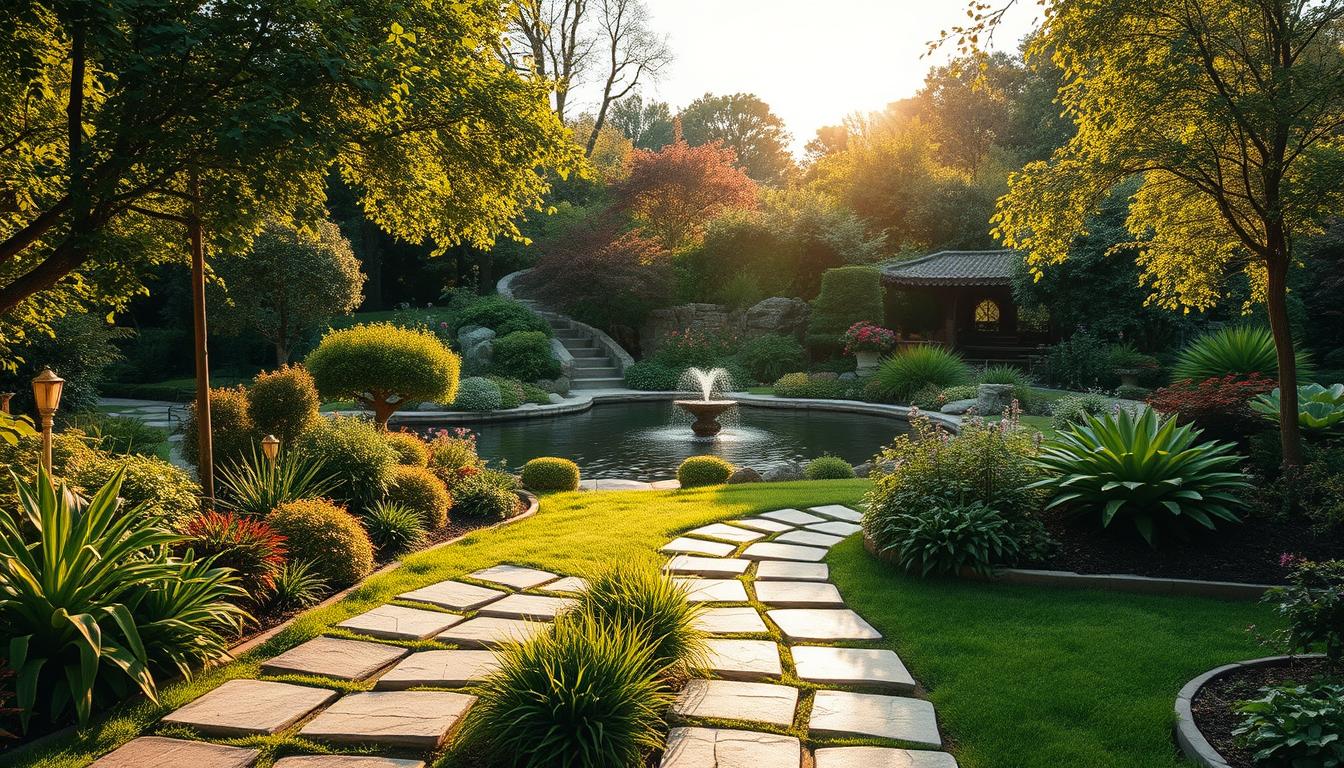Creating a beautiful outdoor space is about more than just planting flowers. It’s a blend of design principles and natural elements that work together to create harmony. One inspiring example is Frederick Bland’s 1-acre Connecticut shoreline landscape. His work showcases how structured layouts and thoughtful plant selection can transform any area.
Bland’s landscape features over 200 linear feet of stone walls and a 75-foot serpentine tapestry hedge. These elements highlight the balance between order and nature. His philosophy, “ABP – Always Be Pruning,” emphasizes the importance of maintaining this balance. This approach ensures year-round interest through evergreens, stone features, and strategic plant choices.
Key features like axial sightlines and transitional gateways add depth and functionality to the space. These ideas can inspire anyone looking to create their own outdoor haven. For more creative landscape inspiration, check out these boho yard decor ideas.
Key Takeaways
- Garden architecture blends design principles with natural elements.
- Structured layouts and plant diversity create harmony.
- Stone features and evergreens ensure year-round interest.
- Axial sightlines and gateways add depth and functionality.
- Regular maintenance is key to maintaining balance.
Introduction to Garden Architecture
Outdoor spaces become transformative when designed with intention. This process, often referred to as landscape design, combines urban planning principles with ecological management. According to the American Society of Landscape Architects (ASLA), it’s the “design of outdoor areas to achieve environmental, social-behavioral, or aesthetic outcomes.”

What is Garden Architecture?
At its core, landscape design is the systematic integration of hardscapes, plants, and spatial organization. Unlike basic gardening, which focuses on plant care, this approach prioritizes structural frameworks. Historically, this concept has evolved from the grandeur of Versailles to the naturalistic designs of Olmsted’s Central Park.
Why Garden Architecture Matters
Modern applications of landscape design go beyond aesthetics. For example, rain gardens are now used for stormwater management. Additionally, well-designed outdoor spaces offer social benefits, such as therapeutic environments and community gathering areas.
| Aspect | Traditional Gardening | Landscape Design |
|---|---|---|
| Focus | Plant care | Structural frameworks |
| Scope | Individual plants | Entire outdoor spaces |
| Outcome | Visual appeal | Environmental and social benefits |
By understanding these elements, you can create outdoor spaces that are not only beautiful but also functional and sustainable. Whether you’re an expert or a beginner, this approach ensures your work stands the test of time.
Planning Your Garden Design
Transforming your yard begins with careful assessment. Whether you hire a pro ($2,000–$8,000) or DIY, a solid plan ensures every element works together. Start by analyzing your space—sun patterns, wind directions, and existing features.
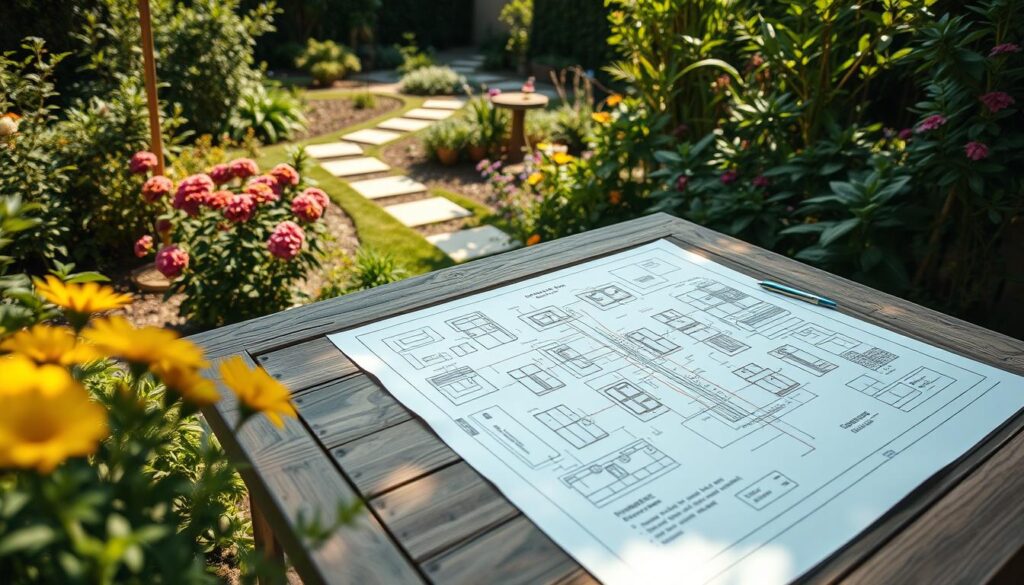
Assessing Your Space
Conduct a site analysis to uncover hidden potential. Measure dimensions, note slopes, and identify microclimates (shady corners, sunny patches). Use graph paper for scale drawings—sketch, measure, transfer, then trace.
- Test your soil for pH and drainage.
- Map sun exposure to pick plant-friendly spots.
- Observe wind flow to shield delicate plants.
Setting Your Goals
Define SMART goals like “attract pollinators” instead of vague ideas. Consider your USDA zone—Frederick Bland’s Zone 7 plants thrive in Connecticut’s climate.
- Budget wisely: Landscaping often adds 10% to home value.
- Prioritize features: Pathways first, decorative elements later.
Key Principles of Garden Architecture
The art of outdoor design lies in balancing form and function. It’s about creating spaces that are not only visually appealing but also practical. Frederick Bland’s work exemplifies this approach, blending structured layouts with natural elements to achieve harmony.
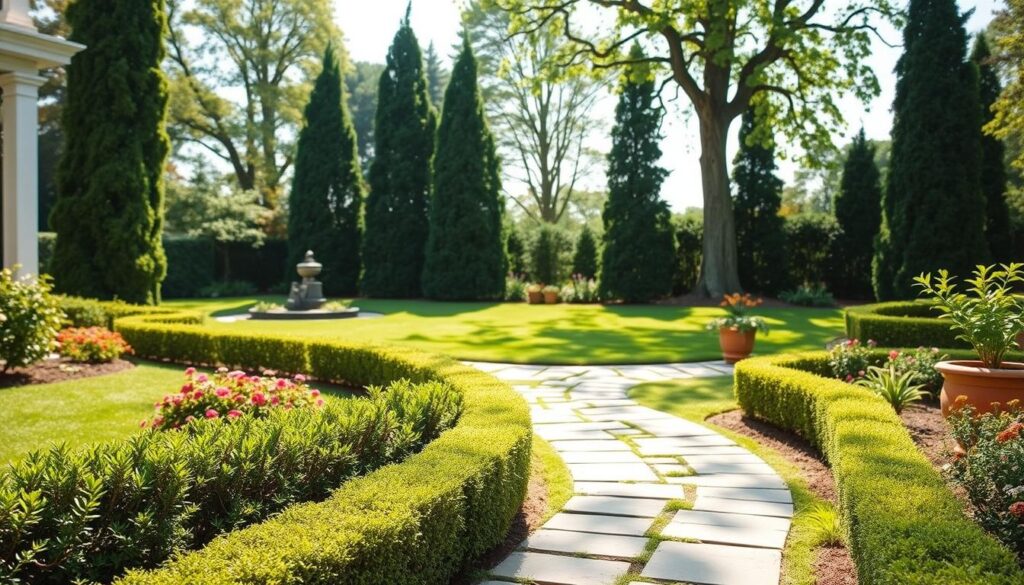
Balance and Harmony
Balance is a cornerstone of effective outdoor design. Bland’s “3 keys to ordered chaos” include axial arrangements, year-round interest, and unifying gateways. For example, his red Gothic gate aligns perfectly with the pool’s centerline, creating a visual connection.
Evergreen hedges serve as living walls, adding structure to the space. Clipped boxwoods blend with informal plantings, offering a mix of formal and natural styles. This approach ensures that every element works together seamlessly.
Functionality and Aesthetics
Functionality is just as important as beauty. Bland’s use of “garden rooms” creates spatial hierarchy, making the space feel organized yet inviting. This concept divides the area into smaller, purposeful sections, such as seating areas or flower beds.
Axial design, inspired by the Forbidden City, enhances visual connections. It guides the eye through the space, creating a sense of flow. These solutions ensure that the outdoor area is both practical and stunning.
| Aspect | Formal Style | Informal Style |
|---|---|---|
| Structure | Symmetrical layouts | Natural, free-flowing designs |
| Plants | Clipped hedges, uniform beds | Mixed plantings, varied heights |
| Functionality | Defined pathways | Meandering walkways |
“The best outdoor spaces are those that feel both intentional and effortless.”
Choosing the Right Plants for Your Garden
Selecting the right plants can transform your outdoor area into a vibrant, year-round retreat. The key lies in understanding your climate zone and picking species that thrive in your environment. Frederick Bland’s Connecticut landscape, for example, showcases the beauty of combining Korean fir, blue Atlas cedar, and cloud-pruned boxwoods. His approach emphasizes the importance of structure and seasonal interest.
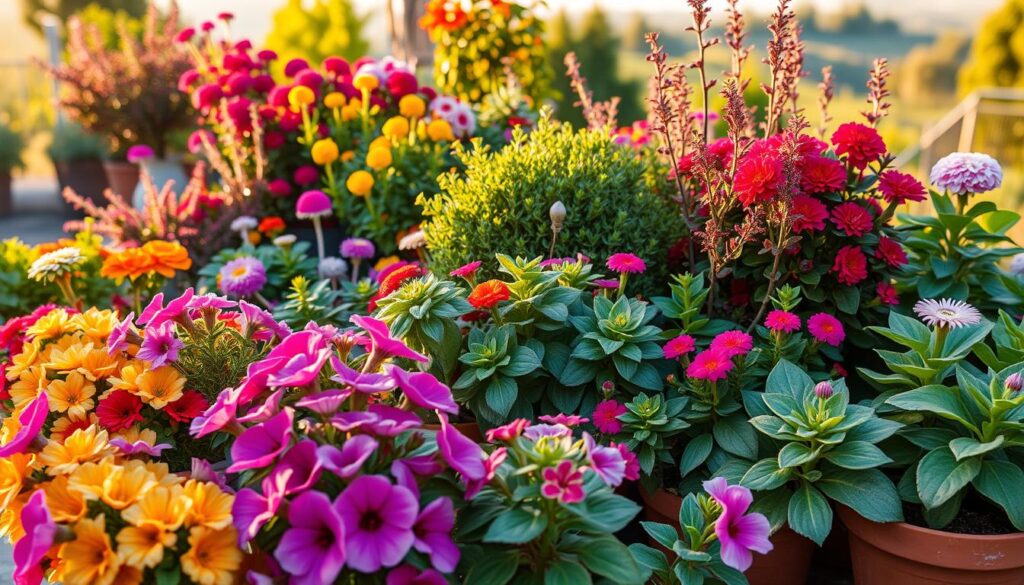
Understanding Your Climate Zone
Your climate zone plays a crucial role in determining which plants will flourish. For instance, Japanese holly thrives in Zones 5-8, while arborvitae adapts well to Zones 3-8. Knowing your zone helps you choose species that are naturally suited to your area, reducing maintenance and ensuring healthier growth.
Consider layering your planting by height. Start with canopy trees, add understory shrubs, and finish with perennials and ground covers. This approach creates depth and ensures every layer contributes to the overall design.
Selecting Plants for Year-Round Interest
To maintain visual appeal throughout the year, focus on evergreens and ornamental grasses. Bland recommends using 75% evergreens for winter structure. Conifers like Korean fir and blue Atlas cedar provide consistent greenery, while ornamental grasses add texture and movement.
Succession planting is another effective strategy. By choosing flowers and shrubs that bloom at different times, you can ensure continuous color and interest. Replace high-maintenance perennials with woody plants to reduce upkeep while maintaining beauty.
| Plant Type | Examples | Benefits |
|---|---|---|
| Canopy Trees | Blue Atlas Cedar | Provides shade and structure |
| Understory Shrubs | Japanese Holly | Adds mid-level texture |
| Perennials | Ornamental Grasses | Ensures year-round interest |
“A well-planned outdoor space is a living canvas that evolves with the seasons.”
Incorporating Hardscape Elements
Hardscape elements are the backbone of any well-designed outdoor space. They provide structure, functionality, and aesthetic appeal. Frederick Bland’s Connecticut landscape, for example, features bluestone pathways and repurposed granite boulders, showcasing how these elements can elevate a design.
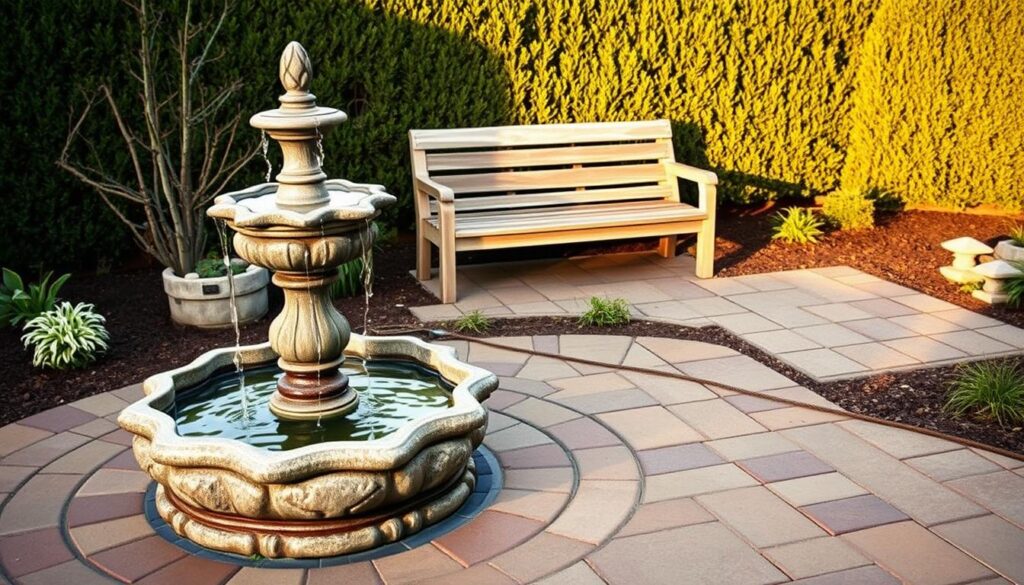
Pathways and Walkways
Pathways are essential for guiding movement and defining areas. When choosing materials, consider durability and style. Flagstone offers a natural look, while gravel is cost-effective and easy to install. Decomposed granite is another popular choice for its smooth texture and versatility.
Building dry-laid stone walls using on-site materials is a sustainable approach. It not only reduces costs but also blends seamlessly with the surroundings. Bland’s 50-foot boulder wall, paired with a boxwood hedge, is a perfect example of this technique.
Water Features and Structures
Water features add tranquility and visual interest to outdoor projects. When designing a water feature, calculate the recirculation pump size based on gallon capacity. This ensures efficient water flow and reduces maintenance.
Lighting is another crucial aspect. Uplighting trees, adding path markers, and using underwater LEDs can transform your space at night. These tips help create a balanced and inviting atmosphere.
“Hardscape elements are the foundation of a functional and beautiful outdoor space.”
Creating Focal Points in Your Garden
Focal points are the heart of any well-designed outdoor space, drawing the eye and creating a sense of purpose. They guide movement and add depth to your layout. Frederick Bland’s Connecticut landscape, for example, uses a red Gothic gate and blue Atlas cedar as living sculptures to anchor the design.
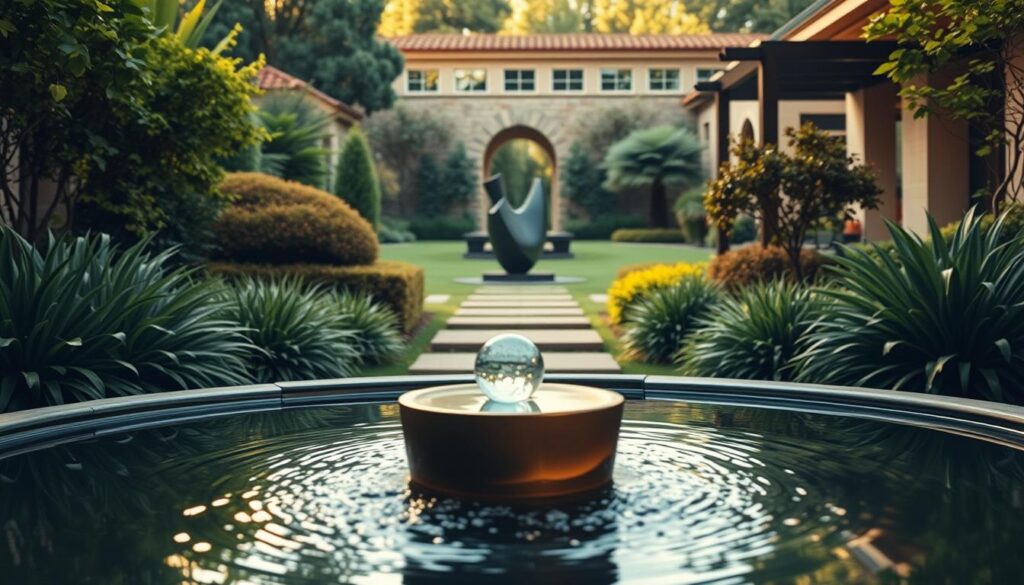
Using Sculptures and Art
Art and sculptures can transform your outdoor area into a visually engaging space. Position these elements at axis endpoints or pathway bends to maximize their impact. Bland’s red Gothic gate, for instance, serves as a visual anchor, aligning perfectly with the pool’s centerline.
Scale is crucial when incorporating art. Aim for pieces that are 1/3 to 1/2 the height of nearby plants. This ensures they stand out without overwhelming the surroundings. Living sculptures, like the blue Atlas cedar, add a dynamic, evolving element to your design.
Designing with Color and Texture
Color and texture play a vital role in creating focal points. Use contrasting textures, such as feathery grasses against glossy holly leaves, to add visual interest. This approach enhances the overall appeal of your space.
Apply color theory to your design. Monochromatic schemes create a cohesive look, while complementary colors add vibrancy. Plan for seasonal changes by incorporating spring bulbs, summer annuals, and fall foliage. This ensures year-round beauty and keeps your space fresh and inviting.
| Element | Tips |
|---|---|
| Sculptures | Position at axis endpoints or pathway bends |
| Color | Use monochromatic or complementary schemes |
| Texture | Contrast feathery grasses with glossy leaves |
| Scale | 1/3 to 1/2 the height of nearby plants |
| Seasonal Planning | Spring bulbs → summer annuals → fall foliage |
“A well-placed focal point can transform an ordinary space into something extraordinary.”
Maintaining Your Garden Architecture
Keeping your outdoor space thriving requires consistent care and attention. Frederick Bland’s ABP (Always Be Pruning) method defies traditional winter-only schedules, emphasizing year-round maintenance. This approach ensures your plants remain healthy and your design stays intact.
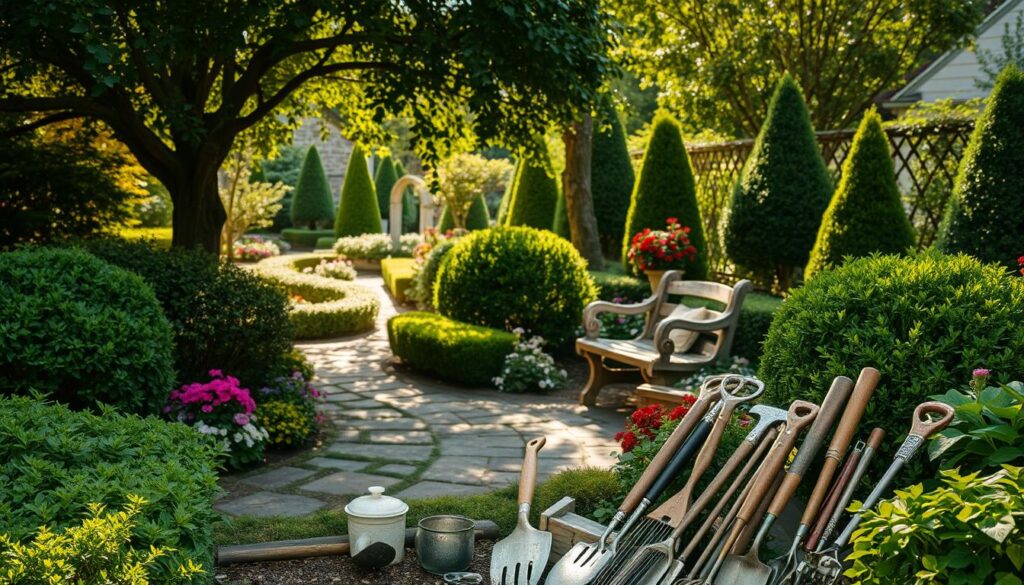
Seasonal Care Tips
Each season brings unique tasks to keep your outdoor area in top shape. In spring, focus on edging beds and removing debris. Summer is ideal for deadheading flowers and monitoring water needs. Fall calls for mulching and preparing plants for colder months.
Winter protection is crucial. Use burlap wraps for evergreens and ensure mulch depth is adequate to shield roots. Regular soil testing helps amend pH levels based on specific plant requirements, ensuring optimal growth.
Pruning and Plant Health
Pruning is a vital part of maintaining your outdoor space. Use thinning cuts to remove entire branches for better air circulation. Heading cuts, on the other hand, help control the shape of shrubs and trees. Always prune with a purpose, whether it’s to encourage growth or remove damaged sections.
Pest management is another key aspect. Identify common issues by examining leaf damage patterns. Early detection allows for timely intervention, preventing widespread damage.
| Task | Season | Tips |
|---|---|---|
| Edging Beds | Spring | Use a spade for clean lines |
| Deadheading | Summer | Remove spent blooms to encourage new growth |
| Mulching | Fall | Apply 2-3 inches around plants |
| Winter Protection | Winter | Wrap evergreens in burlap |
“A well-maintained outdoor space is a testament to thoughtful care and dedication.”
Conclusion
A well-balanced outdoor space combines thoughtful design with natural beauty. Frederick Bland’s work demonstrates how structured layouts and strategic plant choices can enhance any landscape. By focusing on axial arrangements, structural plants, and transitional elements, you can create a harmonious environment.
Implementing these ideas doesn’t have to happen overnight. Consider a phased approach over 3-5 years to manage costs and effort. For complex projects, consulting ASLA-certified professionals ensures your vision aligns with practical solutions.
As Bland once said, “Good design marries the collector’s passion with the architect’s discipline.” Let this philosophy guide your journey to creating a stunning outdoor space.
Share your progress with us! Use #HarmoniousSpaces to inspire others with your landscape transformations.

